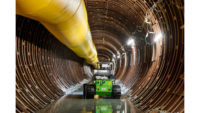
Like a real-life Tony Stark—the engineer-protagonist of the "Ironman" movies—software developer Nelson Paez has created a technology that could help augment and automate operations of everything from military weapons to construction machinery, pushing forward the unmanned-systems industry. But also like Stark, Paez doesn’t want to license his technology exclusively to the armed forces. His new software for controlling unmanned vehicles will be commercially available this August.
“Exactly what happened in the mobile and in the PC industry can happen in the unmanned-systems industry,” says Paez, CEO of DreamHammer Inc., Santa Monica, Calif. “You need a platform that can work across multiple systems.”
Ballista, Paez’s operating system for controlling unmanned equipment, could act as a platform—akin to Apple's iOS platform—for programmers to begin building applications to control unmanned vehicles for land, air or sea.
Paez says his company has worked with the U.S. military for years; in fact, the military is testing Ballista now. The military may use the software to network and consolidate the many proprietary drone-control systems currently being used into a single common interface.
As of now, military drones are controlled through a host of contractors that use their own specialized software, which is not interoperable, says Paez. Ballista offers a video-game-like application-programming interface (API) that is light enough to run on a tablet. With Ballista, Paez says, one person can control multiple drones. Future updates can be pushed without reprogramming the software or rebuilding the hardware—capabilities unavailable in today’s drone world.
But Paez says Ballista’s influence can reach well beyond the military and affect many segments of society, from transportation to construction.
Jochen Teizer, assistant professor of the Georgia Institute of Technology’s school of civil and environmental engineering, says he sees automating control of robots on jobsites as a key part of the future of construction. The development of control systems is a critical step, he adds.
“You could have automated robots or mobile platforms that move from one part of the site to the other,” says Teizer. For example, robots could be equipped with mobile sensors to track worker location for safety research, he notes. Ballista also could help bring about Teizer’s dream of roving sensors that collect data from around the jobsite; using current technology to collect this data is cost-prohibitive, he says. However, like other once-exotic technology, the cost of unmanned equipment will come down.
“Computers used to be so expensive that only the government and Fortune 100 companies could afford them—that’s where we are with unmanned vehicles,” says Paez. “It is only when technology becomes ubiquitous to the public that it explodes.”




Post a comment to this article
Report Abusive Comment